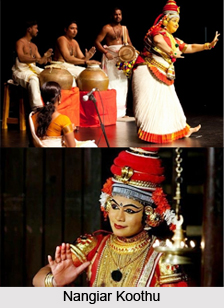 Nangiar Kuthu, also spelt Nangyar Koothu, is an allied traditional art form that emerged from Koodiyattam, the earliest surviving ancient Sanskrit theatre art of India. It is performed traditionally by the women of the Ambalavasi Nambiar community of Kerala, known as the Nangyarammas, but has transcended the caste barrier since the second half of the 20th century.
Nangiar Kuthu, also spelt Nangyar Koothu, is an allied traditional art form that emerged from Koodiyattam, the earliest surviving ancient Sanskrit theatre art of India. It is performed traditionally by the women of the Ambalavasi Nambiar community of Kerala, known as the Nangyarammas, but has transcended the caste barrier since the second half of the 20th century.
An offshoot of Koodiyattam, Nangiar Koothu is a solo dance drama with an antiquity of 1500 years, also performed in the Koothambalams, the traditional temple theatres of Kerala. It is the sole domain of female artistes, primarily centred on the stories depicting the life of Lord Krishna, taken from the text "Sree Krishna Charitham" by the Cheraman King Kulashekaran. During the performance, the actress presents the longwinded stories of Lord Krishna through hand gestures, facial expressions and body movements indigenous to Bharata Muni"s "Natyashastra", in the accompaniment of recital verses sung and interpreted through mime and dance, and the music of the resonant pot drum Mizhavu and cymbals called Ilathalam. The Mudras, though the same as in Koodiyattam, are even more elaborate.
Nangiar Koothu is still performed in Kerala temples like Vadakkunnatha temple in Thrissur, Sri Krishna temple in Ambalapuzha, Koodal Manickyam temple in Irinjalakkuda and Kumaranalloor temple in Kottayam. In one of the enactments "Shailooshakam, Akrooragamanam" (The visit by Akroora), an episode from the Sree Krishna Charitham would be enacted, depicting Akroora, the benign servant of the cruel King Kansa, biding his time for an opportunity to meet Lord Krishna. Luck favours him when Kansa orders him on a mission to bring Krishna and his brother from Vrindavana to his palace. The elation of Akroora and his reminiscence as he travels to Vrindavan, would be vibrantly expressed and portrayed by the Nangiar (actress) on stage.
One of the most well-known and accomplished performers of Nangiar Koothu is the late Margi Sathi, who breathed her last in 2015. She is the leading exponent of this subsidiary art of Koodiyattam.
Related Articles:
Forms of Indian Theatre
Kerala
Folk Theatre of Kerala
Sanskrit Theatre
Classical Indian Dance Drama
Koothu
Indian Classical Dance
Koodiyattam, Folk Theatre of Kerala
Natyashastra
Bharata Muni
Mukhabhinaya, Mime Theatre




















